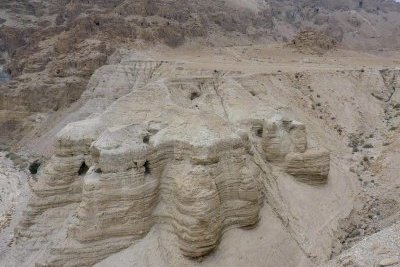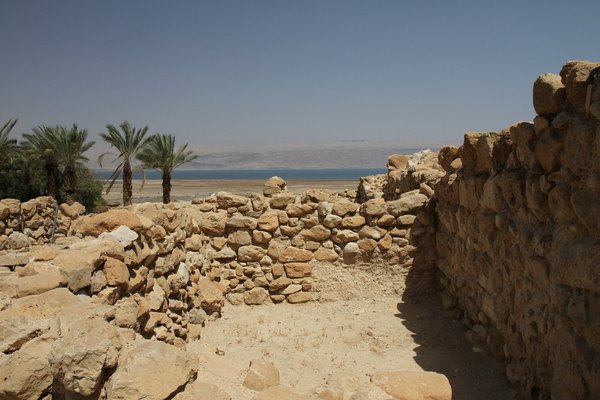Palestine
QUMRAN: Caves and Monastery of Dead Sea Scrolls
Qumran is an archaeological site located on a plateau near the northwest shore of the Dead Sea.
The site is known for the discovery of the Dead Sea Scrolls, which were found in the Qumran Caves between 1947 and 1956. The Dead Sea Scrolls are ancient religious and non-religious Jewish texts, including the oldest known manuscripts of the Bible.
Site Info
Official Information
- Full Name
- QUMRAN: Caves and Monastery of the Dead Sea Scrolls (ID: 5707)
- Country
- Palestine
- Status
-
On tentative list 2012
Site history
History of QUMRAN: Caves and Monastery of Dead Sea Scrolls
- 2012: Added to Tentative List
- Added to tentative list
- Type
- Cultural
- Criteria
Links
- UNESCO
- whc.unesco.org
All Links
UNESCO.org
- whc.unesco.org — whc.unesco.org
News Article
- Feb. 9, 2017 archaeology.org — Twelfth Cave Discovered at Qumran
Community Information
- Community Category
- Archaeological site: Near Eastern
Travel Information
Recent Connections
News
- archaeology.org 02/09/2017
- Twelfth Cave Discovered at Qumran
Recent Visitors
Visitors of QUMRAN: Caves and Monastery of Dead Sea Scrolls
- Alexander Lehmann
- Argo
- bergecn
- Can SARICA
- Cezar Grozavu
- Dennis Nicklaus
- Dimitar Krastev
- Eric Lurio
- GabLabCebu
- George Gdanski
- Hughes1920
- Jan Zimmermann
- Jay T
- João Aender
- John Smaranda
- Maciej Gil
- Małgosia Łupicka
- Matthewsharris
- nan
- Patrik_globe
- Roman Raab
- Rudegirl
- sncjob
- Solivagant
- Ssong.x
- Tom Flaten
- Vernon Prieto
- Walter
Community Reviews
Show full reviewsGabLabCebu
QUMRAN: Caves and Monastery of Dead Sea Scrolls
QUMRAN: Caves and Monastery of Dead Sea Scrolls (On tentative list)

The Dead Sea Scrolls are indeed one of the great written archaeological finds of the past century. I visited the Shrine of the Book in the Israel Museum where reproductions of these ancient scripts are accessible for the public to visit and where many of the original finds are actually stored. This review, however, is not about the scrolls, but the place where they were originally found, Qumran. Qumran today is another ruin in Israel's national park system, but there are a few very interesting things to note about it. First of all, Qumran is actually within the 1949 UN-recognized boundaries of Palestine, but as implied earlier, in territory completely controlled by Israel at present. It is located along the main road by the Dead Sea, which causes it to fall under the itinerary of most tourists on a Masada and Dead Sea day trip from Jerusalem, and we were no exception to that. Just as we visited most places in Holy Land, my family and I visited Qumran with our own vehicle and guide. As much as Qumran is advertised as the site of the Dead Sea Scrolls, one wouldn't know that simply by looking at the site, and as such, that (over-hyped) significance of the find should not sway our opinions of the site. To be honest, the ruins didn't look too impressive at first glance, and I think everyone who visits is just waiting to get to the view of the legendary caves. I think that this …
Keep reading 0 commentsSolivagant
QUMRAN: Caves and Monastery of Dead Sea Scrolls
QUMRAN: Caves and Monastery of Dead Sea Scrolls (On tentative list)

It seems rather strange to be reviewing a Palestinian Tentative List site when we visited it as an Israeli National Park using our Israeli 2 week “multi visit” pass! The answer lies in the fact that, whilst it may be within “Palestine” as recognized by the Oslo Accords, Qumran is still under full Israeli control.
The site of course has “World-wide” fame as the location where the Dead Sea Scrolls were found. We hadn’t expected that there would be much to see but found the visit of interest in providing background into the “Essenes” – an ascetic sect from around the 2nd century BCE who wrote the scrolls. The site consists primarily of their excavated communal living quarters (Ritual baths, refectory, scriptorium etc) with distant views of caves in the hillside and in the nearby eroded Wadi (photo) – including the original “Scrolls Cave”. There is also a small museum and a dramatized audio visual presentation which portrays their life, beliefs and practices. The site gets busy with coach trips ex Jeuralem for whom it is yet another stop on their Dead Sea/Masada expeience. Without our prepaid pass we might have passed it by given its cost of 29NIS (6.1 Euro) for a pretty short visit - 45 minutes unless you go for a hike towards the hills (these were closed when we were there because of fears of flash floods). On reflection that would have been a mistake and I am glad we have a personal “vision” of …
Keep reading 0 comments
